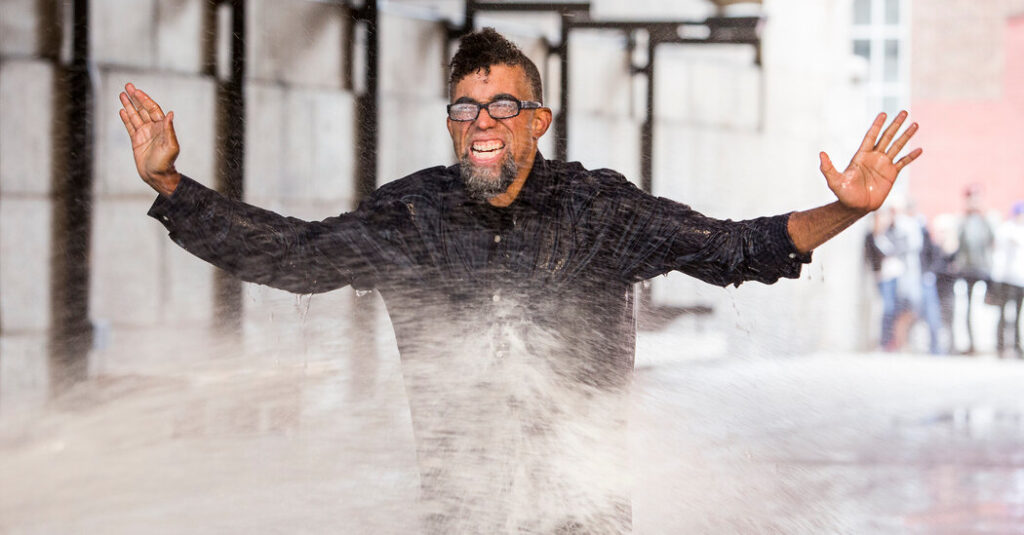
Most “political” art destined for galleries and art fairs has zero effect on the larger world, yet artists keep making it. Why? In hopes of soothing their souls and shaping the collective karma, I guess. A cohort of 17 such karmic point-scorers make up “Paint the Protest” at Off Paradise, a group show organized by Nancy Spector, the former artistic director and chief curator of the Solomon R. Guggenheim Museum.
Most of the artists are familiar, though some of the work to which their names are attached may not be. Three near-abstract paintings of blank protest placards by Richard Prince, dating to 1994, has little obvious connection to his sardonic pop-culture appropriations. A recently minted NFT animation, “Untitled 2021 (rich bastards beware),” by Rirkrit Tiravanija could be by pretty much anyone. More interesting is a set of graphite drawings he commissioned from some of his art school students, based on newspaper photographs of political demonstrations taking place throughout the world. The drawings date from 2015; the events depicted then could be happening today: The beat, on perpetual repeat, goes on.
A couple of artists in the show deliver versions of traditional protest props. Sharon Hayes’s textile banners from 2021 bear the irresolute phrases “What Do We Want” and “When Will This End.” That the words themselves, collaged from scraps of torn-up newspapers, probably wouldn’t survive a light rain shower if the banners were actually carried into the street may say something about an apparently diminished belief in the effectiveness of 1960s-style mass demonstration in a social media age.
At the same time, a cluster of abstract paintings by Jacqueline Humphries mounted, like signs, on sticks, feels up to the political moment in light of China’s recent “white paper revolution,” which found protesters, in an anti-authoritarian collective gesture, displaying blank sheets of paper, a strategy conceived both to baffle specific censorship and accommodate many readings.
In Spector’s show, I’m glad to renew acquaintance with Dread Scott’s “On the Impossibility of Freedom in a Country Founded on Slavery and Genocide,” a photograph of a 2014 performance in which the artist — one of our best — had himself blasted with fire hoses in memory of police attacks on Black protesters in Birmingham, Ala., in 1963. And to be able to re-experience, even in a distracting group setting, Raven Chacon’s breath-catching audio piece “Silent Choir (Standing Rock),” a highlight of the 2022 Whitney Biennial, is a gift.
Introducing work by new artists, or those outside the canonical circle, is a karmic obligation. The show does that with the work of Aaron Huey — apocalyptic A.I.-generated images, printed on seed paper, of Washington, D.C., in flames — and with photographs of the young Cuban-born, Miami-based Francisco Masó performing choreographed moves that he calls “obtuse exercises for dissenting bodies.”
Spector and Off Paradise’s director, Natacha Polaert, have taken care to acknowledge, and soften, the profit motive behind institutionally nurtured “political” art and tweak it a little: All proceeds from the sale of certain works in the show will go to Downtown for Democracy’s get-out-the-vote initiative.
Spector has arranged for at least one strong what-goes-around-comes-around touch. She has included a 2018 piece by the veteran activist artist Marilyn Minter, a wall plaque printed with obscenely misogynistic quotes from Donald Trump’s infamous 2005 “Access Hollywood” tape. And she has hung the piece, alone, in the gallery’s bathroom.
The installation there is a reminder that in 2017, when the Trump White House asked the Guggenheim for the loan of a van Gogh painting from its collection, Spector, as chief curator at the time, responded with a counteroffer. She proposed sending, instead, a contemporary piece: a sculpture (by Maurizio Cattelan) of a full-scale, fully functional 18-karat gold toilet. The work was titled “America.” Her rude gesture caused quite a stir within the art world and — this is what counts — even beyond it.
Paint the Protest
Through Jan. 27 at Off Paradise, 120 Walker Street, Manhattan; (212) 388-9010, offparadise.com.
You may also like
-
Capturing Stories, Connecting Worlds: The Journey of Cade Chudy and 4th Shore Productions
-
The Multidimensional Universe: A New Theory Unfolds
-
Lights, Camera, Impact: Antoine Gijbels’ Inspiring Videography Journey
-
Striking a Balance: Sophie Annaston’s Journey to Setting Boundaries in the Influencer World
-
Unlocking the Superpower of Critical Thinking: A Conversation with John Chetro Szivos

